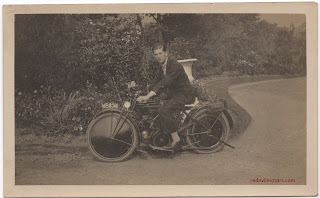I've owned this machine for more years than I care to admit now. It was an unloved and unknown bike in a local auction and I won it as the sole bidder with a chancer bid. Purchase came with a first flush of enthusiasm, I started it up and took it to an event or two. Then I decided that if it was to be used in anger the motor should be checked out - the motor had been run on castor oil. As I was short on time and heavy on projects it went up to Paul Henshaw of Performance Classics in Wales. I collected it running, Paul had done a cracking job as expected in stripping, cleaning and servicing. Then a misfire crept in and it was evident that the mag needed rebuilding as well as the engine. In the meantime I managed to get the bike road registered.
The mag was duly rebuilt but I got the timing wrong. Trying to test run a bike with no kickstart when you live on top of a hill is not much fun so I got dispirited and wheeled it to the back of the garage for a period of contemplation.
 |
1950s Charlie Lucas Royal Enfield 500 Twin.
|
From purchase onwards I had no idea who made the bike, I had a couple of leads but they got me nowhere. Then out of the blue I saw an original picture of the bike from back in the day in the letters section of Old Bike Mart magazine. A breakthrough moment for the bike and for my enthusiasm.
It was always evident that the bike was of decent build quality and a step up from something homemade and so it proved to be. The engine is a Royal Enfield 500 twin, not a particularly noteworthy sports engine but back in the early postwar club racing scene you made do with what you had. The frame is very similar to a Featherbed Norton but with a few subtle differences. The gearbox is a rare close ratio and the only real concession to tuning seems to be the twin carbs and megaphone pipes.
The ID of the bike is that it is a Charlie Lucas made machine. Charlie was a bike dealer in Watford who had a sideline in producing speedway frames and bespoke frames for road racing. It's unclear of how prodigious his output was but it is fair to say low. Charlie was famous for making the frame of the 'Melem Special' a successful one-off DOHC 250cc machine campaigned in the early and mid fifties.
 |
1950s Charlie Lucas Royal Enfield 500 Twin.
|
The next breakthrough came in the purchase over the summer this year of a set of electric starter rollers from ebay. A total gamechanger in fettling something like this. I re-timed the bike and got it running sweet. Next step road tests. It's quite a buzz riding an original and unrestored fifties road racer out on public roads. Riding position is brutally uncomfortable for my six foot two frame, the footrests are ludicrously high and all my weight falls on to my wrists. The gearing is very high and to get a decent pace up the bike needs to be thrashed, brakes are standard Enfield and though fine for a Bullet or suchlike are slightly below par for this application. I took the bike along to a local VMCC run for fun but had to decline and head back home from the start such was the discomfort...
Next steps are light fettling and further investigating the bike's history with the leads I have. It's remarkable to have a period race bike in such unmolested and original condition, this perhaps means that it wasn't used much and will be hard to trace in race results / programmes? Some time in the bike's life 18 inch rims have been fitted, I have the original 19 inch ones and shall fit these back on soon. That should improve the grace of the bike and make it look slightly less chunky. Moving the footrests will be tricky but changing the handlebars is not, so a pair of swan-neck clip-ons will be substituted. Lowering the gearing with a smaller gearbox sprocket should make it slightly more manageable (I barely managed top gear on test runs). That should all be easily achievable by next season. After that it's just to get out and enjoy using it.


























































